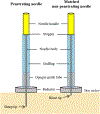Effects on Acupuncturist Blinding: Different Diameters of Double-blind Acupuncture Needles
- PMID: 33038081
- PMCID: PMC8058780
Effects on Acupuncturist Blinding: Different Diameters of Double-blind Acupuncture Needles
Abstract
Context: It's difficult to conduct experiments using a double-blind design in controlled clinical trials of acupuncture. To resolve this problem with blinding, we designed double-blind needles (DBNs) with stuffing to mimic the resistance felt during insertion of a regular acupuncture needle. Results of the past studies using 0.16 mm diameter DBNs found that the resistance felt by the acupuncturists during insertion successfully blinded them.
Objective: The study intended to compare the effects on an acupuncturist's blinding when the practitioner used penetrating DBNs with 0.14, 0.16, 0.18, and 0.20 mm diameters.
Design: We conducted a double-blind randomized trial.
Setting: The study took place at the Japan School of Acupuncture, Moxibustion. and Physiotherapy in Tokyo, Japan.
Participants: The participant was one licensed acupuncturist who performed 320 needle insertions during acupuncture for 20 healthy students, who were familiar with acupuncture and who attended the Japan School of Acupuncture, Moxibustion, and Physiotherapy.
Methods: The acupuncturist was informed she would administer a penetrating or non-penetrating needle; however, only penetrating needles were used. She inserted the four sizes of needles in both of each student's dorsal forearms using an alternating twirling technique. This procedure was repeated once more on another day, with at least one day between sessions.
Primary outcome measures: After the acupuncturist removed each needle, we asked her to guess: (1) the type of needle inserted, (2) her level of confidence in the guess, and (3) the clues that contributed to her guess. A chi-squared test was used to determine whether the ratio of correctly or incorrectly identified needles met an expected probability of 0.5 for each needle diameter.
Results: Of the 320 needle insertions, the acupuncturist correctly identified 54% of 0.14 mm, 45% of 0.16 mm, 46% of 0.18 mm, and 50% of 0.20 mm needle insertions. The correct and incorrect ratios of identified needles were fitted with a probability of 0.5, with no significant differences in the acupuncturist's confidence (P = .16). In 99% of the tests, the cue that contributed to the acupuncturist's guess was the feeling of the needle insertion.
Conclusion: These findings indicate that the differences in the diameters of DBNs from 0.14 to 0.20 mm didn't significantly affect the acupuncturist's blinding.
Figures
Similar articles
-
Tapping-in method (skin penetration technique) with a placebo needle for double-blind acupuncture trials.J Altern Complement Med. 2013 Apr;19(4):308-12. doi: 10.1089/acm.2012.0056. Epub 2012 Oct 25. J Altern Complement Med. 2013. PMID: 23098695 Clinical Trial.
-
Double blinding with a new placebo needle: a further validation study.Acupunct Med. 2010 Sep;28(3):144-8. doi: 10.1136/aim.2009.001230. Epub 2010 Jun 7. Acupunct Med. 2010. PMID: 20530096 Free PMC article. Clinical Trial.
-
A placebo acupuncture needle with potential for double blinding - a validation study.Acupunct Med. 2008 Dec;26(4):224-30. doi: 10.1136/aim.26.4.224. Acupunct Med. 2008. PMID: 19098693 Clinical Trial.
-
Systematic review of acupuncture placebo devices with a focus on the credibility of blinding of healthy participants and/or acupuncturists.Acupunct Med. 2018 Aug;36(4):204-214. doi: 10.1136/acupmed-2017-011484. Epub 2018 Apr 18. Acupunct Med. 2018. PMID: 29669794
-
Clinical trials of acupuncture: consensus recommendations for optimal treatment, sham controls and blinding.Complement Ther Med. 2001 Dec;9(4):237-45. doi: 10.1054/ctim.2001.0489. Complement Ther Med. 2001. PMID: 12184353 Review.
References
-
- Kaptchuk TJ. The double-blind, randomized, placebo-controlled trial: gold standard or golden calf? J Clin Epidemiol. 2001; 54:541–9. - PubMed
-
- Kaptchuk TJ. Placebo needle for acupuncture. Lancet. 1998; 352:992. - PubMed
-
- Takakura N, Takayama M, Kawase A, Yajima H. Double-blind acupuncture needling: Does patient reaction reveal needle authenticity? Med Acupunct. 2008; 20:169–74.
-
- Takakura N, Yajima H. A placebo acupuncture needle with potential for double blinding - A validation study. Acupunct Med. 2008; 26:224–30. - PubMed
Publication types
MeSH terms
Grants and funding
LinkOut - more resources
Full Text Sources
Medical
Miscellaneous



